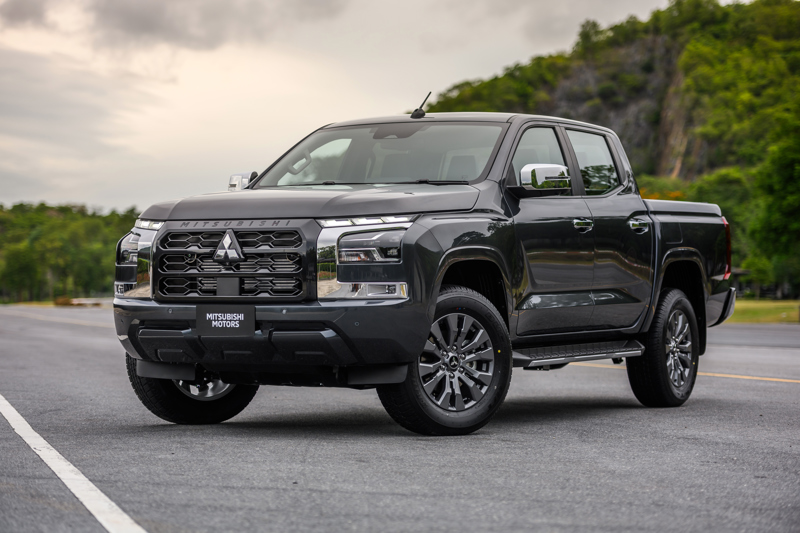Mitsubishi has revealed the all-new 6th generation Triton in Bangkok, Thailand, the first new Triton in almost a decade.
And it genuinely is "all-new" as well, with a new ladder-chassis (that will also form the basis of future utes from Nissan and Renault), as well as a newly-developed 2.4-litre turbo diesel engine to go with the chunky new styling.
The Triton will go on sale immediately in Thailand, rolling out across the ASEAN area in the coming months. There is no word on when the new Triton will hit our shores yet, but it will go on sale in Japan in early 2024 - the first time in 12 years that Mitsubishi has offered the Triton in its home market.
Local specification is also as-yet uncomfirmed, but the Triton will be offered in three body styles in Thailand; double-cab, single-cab and club-cab.

Mitsubishi has gone down a similar styling road as Ford and Volkswagen have with the Ranger and Amarok, with a bold American truck-like look, with none of the curves of the previous Tritons.
The "Dynamic Shield" front face is retained on the new Triton, but has been updated to be straighter and chunkier. A big square grille dominates the front, with chunky squared-off wheel arches and a large, flat bonnet completing the "big truck" look.
Mitsubishi says the "horizontally-themed body sides" feature large, solid surfaces that "emphasise the robust doors" while contrasting with the fender panels to make them appear wider, "emphasising stability and toughness."

Up the back, the tray bed height has been lowered by 45mm (to 820mm) compared to the previous model, while Ranger-esque steps have been added to the rear bumper to aid access to the tray.
On the inside, the front seats have been fully redesigned to provide firm lower back support while the shoulder areas provide ease of movement with an open shape, which helps reduce driver fatigue, while the instrument panel uses a horizontal theme to allow drivers to easily see all monitors, metres and switches while driving
Mitsubishi says that on-road performance has been "greatly enhanced" with upgraded drive modes and electronically controlled active yaw control combined with its Super Select 4WD-II system. The new Triton also includes adaptive cruise control for the first time, as well as new safety features and emergency support using connected car technology.

The newly developed ladder frame has a 65 percent greater cross-sectional area than the previous model, with an increase in bending rigidity of 40 percent and torsional rigidity of 60 percent, while an increased use of high-tensile steel has seen a weight reduction. The body is also lighter than the previous model through the use of a new 1180 MPa high-tensile steel.
The new uet continues to use Mitsubishi Motors’ two 4WD systems - Super Select 4WD-II and Easy Select 4WD - with Super Select 4WD-II equipped with a centre torque sensing LSD that distributes 40 percent of power to the front and 60 percent to the rear.
Models with the Super Select 4WD-II system can select from the four options of 2H (rear-wheel drive), 4H (full-time four-wheel drive), 4HLc (locked centre differential) and 4LLc (low range with locked centre differential).
The Triton also now gets seven drive modes split across the 4WD options, including Normal mode (available in all four-wheel drive modes), Eco mode for prioritisation of economy (in 2H), Gravel and Snow modes (4H), Mud and Sand modes (4HLc) and Rock mode (4LLc).
Lower-spec models with Easy Select 4WD just get 2H, 4H and 4L, while models equipped with Super Select 4WD-II also get Mitsubishi's new active yaw control system that improves cornering performance by applying light braking to the inside front wheel when cornering.
Mitsubishi has developed new suspension for the Triton, retaining a double wishbone structure for the front suspension, with a lighter leaf spring system together with thicker shock absorbers at the rear. The upper suspension mounting arm has been moved higher to increase the stroke by 20mm, providing improved road-holding and ride comfort.

The newly developed 4N16 2.4-litre turbo diesel engine comes in three different output specifications - the high-output version is equipped with a new turbo charger and new combustion system, producing 150kW and 470Nm, while two versions of the standard specification engine get a variable geometry turbo charger and produce 110kW/330Nm and 135kW/430Nm respectively. Six-speed manual and automatic transmissions are available with all three engine variants.
While we would normally expect to only see the high-output version released in New Zealand, the tougher Clean Car programme could well prompt MMNZ to consider one of the lower powered engines as well, depending on potential emission figures, which have yet to be revealed.
Conspicuous by its absence from the reveal is any mention of electrification, either by way of hybrid, plug-in hybrid or fully electric powertrains. However, some form of hybridisation is a certainty for the Triton and should follow shortly after the launch.



















